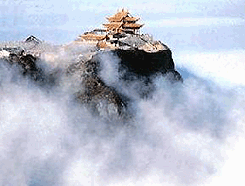Located in the southwest of Emei County, Sichuan Province, the Emei Mountain is one of thefour Buddliist shrines.The mountain is known for its stiff cliffs, highrising peaks,roating waterfalls, gurgling springs, towering ancient trees and fragrant flowers. It has been described as a beauty spot under heaven” by Chinese men of lettera since ancient times. The highest peak of the is 3,099 metres above sea level. The total rugged road to its summit is 75 kilometres long.In the Eastern Han Dynasty(25-220), monks and priests eame to the mountain to build temples.
 Constrnction lasted l,800 years.The Emei mountain is regarded as the “capital of fairyland and kingdom of monks”. Now there remain only 70 temples on the mountian. There are plcnty of historical sites, and a lot of
Constrnction lasted l,800 years.The Emei mountain is regarded as the “capital of fairyland and kingdom of monks”. Now there remain only 70 temples on the mountian. There are plcnty of historical sites, and a lot of
precious cultural relics on tbe mountain. Inside Baoguo.Temples a Large china statue of Buddha with a height of 2.4 metres made in the Ming Dynasty Looks,alive. bright and shining. A big bell, also made in the Ming Dynasty with a weight of 12.5 tons, has more than 60,000 charac-ters on
it. The sound produced by the bell is deep, and its echo spreads as far as 15 kilometres.
Fuhu Temple, the biggest Buddhist temple on the mounfain, has 13 halls. In the temple, a 6-metre 17-storeyed bronze tower made in the Yuan Dy-nasty(1271-1368) has sone 4,700 engraved Buddhist figurines on it. The 20,000-character Huayan Sutras are well preserved in the temple.
 Wannian Temple has a huge bronze statue of Samantab-hadra mounted on a white elephant.made in the Song Dynasty (960-1279). The bronze is 7.35 metres high and weighs 62 tons. Inside the the temple, there are several hundred other bronze or iron statues. The Copper Hall with a gold-plated roof in Woyun Temple, built in the Ming Dynasty on the mountain top, is eight metres high, 4.8 metres wide and 4.3 metres deep. The whole body of the hall was made of copper with a gold plated roof inside the hall, there is a five-metre high bronze statue of Samantabhadra mounted on an elophant and 24 bronze Buddhist images. Outside the hall is a bronze tablet, on which 2,564 characters were engraved by calligraphers Wang Xizhi of the Eastern Jin Dynasty(317-420)and Chu Suiliang of the Tang Dynasty(618-907).
Wannian Temple has a huge bronze statue of Samantab-hadra mounted on a white elephant.made in the Song Dynasty (960-1279). The bronze is 7.35 metres high and weighs 62 tons. Inside the the temple, there are several hundred other bronze or iron statues. The Copper Hall with a gold-plated roof in Woyun Temple, built in the Ming Dynasty on the mountain top, is eight metres high, 4.8 metres wide and 4.3 metres deep. The whole body of the hall was made of copper with a gold plated roof inside the hall, there is a five-metre high bronze statue of Samantabhadra mounted on an elophant and 24 bronze Buddhist images. Outside the hall is a bronze tablet, on which 2,564 characters were engraved by calligraphers Wang Xizhi of the Eastern Jin Dynasty(317-420)and Chu Suiliang of the Tang Dynasty(618-907).
On the top of the moimtain. a cireleof violet,indgo, blue,green, yellow, orange and red lights may be observed in the clouds, and you may feel as if you were caught in the circle, which moves with your shadow. This is the famed “pecious Emei lights” or “Buddha’s halo”. On mountain
slopes, monkeys often come out to”rob” you: they may extend their hands begging for food. If you show your empty hands, they usually let the matter go. But sometimes an in-sistent monkey will try to seize your coat to make sure you really have nothing to offer.